JEAN DUNAND
An exceptional reference
Jean Dunand intends to become the reference in the ultra-small niche of exceptional timepieces. Two years after having presented the Tourbillon Orbital, the brand is now introducing its latest creation: Shabaka. Named after the first Egyptian pharaoh of the 25th dynasty, this timepiece is surprising, both from a design point of view – obviously inspired from Egyptian art – and its display – calendar indications appear on four small cylinders or rollers that replace the traditional discs. Under this very particular exterior, the Shabaka is a minute repeater on a cathedral gong as well as a perpetual calendar complete with an instantaneous jump. A performance protected by four registered patents.
In addition to its totally singular design, due not only to the four rollers, but also to the very special features on the dial and the very angular case (46 mm curvex), the Shabaka represents a veritable technical challenge, the type that attracts its designer, Christophe Claret.
The first challenge to overcome: the transmission of information to the rollers. This is not direct, as is the case with discs, but requires 90-degree transmission systems, operating in an extremely narrow space.
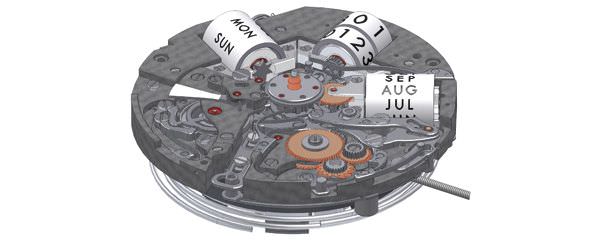
Jean Dunand Shabaka
The second difficulty: the date indication is made on two rollers mounted in parallel but that do not turn at the same time. Therefore, in this case, it was necessary to create a double co-axial transmission.
Third obstacle: correcting the indications displayed on the cylinders (for the day, date, and month) is made using an original system of levers connected between themselves. Known and regularly used in ‘large mechanics’, it was necessary to finely adapt this technique to the micro-mechanical dimensions of watchmaking. The indications are activated not by traditional correctors, but by two pushpieces similar to a chronograph that allow the wearer to adjust the days (at 2 o’clock), or the complete calendar (at 4 o’clock). A third co-axial pushbutton, integrated into the crown permits the regulation of the months and years.
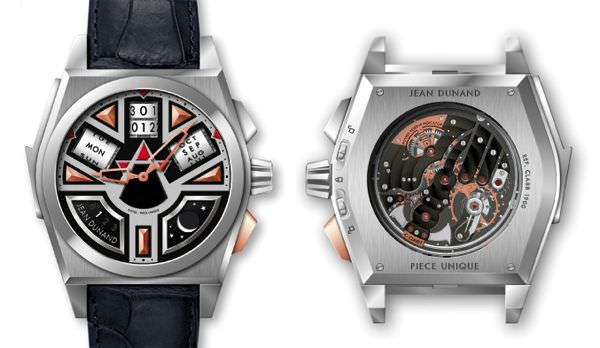
But, Shabaka’s technical originalities do not stop at these impressive aluminium cylinders (chosen for their lightness), that instantaneously jump at midnight, thanks to a pre-armed triggering mechanism. The leap year indication is also just as surprising. A white plate under the dial shows through the cut-outs, between 7 and 8 o’clock, highlighting the normal years (1, 2, or 3) as they pass, while when leap year arrives, the white plate illuminates the letter ‘B’ (for bissextile).
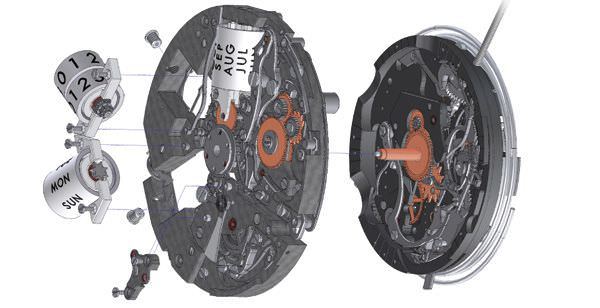
On the opposite side of the dial is a very original and precise moon phase indication, displayed by two black discs that progressively slide over the surface of the immobile moon, like the shadow of the earth that eclipses the moon from the left when it wanes, or reveals it on the right when it waxes. The watch’s moon deviates from the real moon by only one day in 120 years.
Integrated into this complex mechanism, the minute repeater strikes on two ca-thedral gongs that go twice around the movement and to which they are linked by contact blocks in order to give a deeper and more resonant sound quality.
On the back of the timepiece is the very original power reserve indicator (be-tween 44 and 48 hours). In fact, it shows the mainspring itself, visible in its open barrel, as it unwinds along a graduated scale. Christophe Claret and his constructors have designed a particular system that allows the movement to maintain constant amplitude, although they are not divulging much information about it.
In order to fit this complex ensemble, made up of 721 pieces, into the case (itself measuring 17.65 mm in thickness, of which 12.2 mm is taken up by the movement alone), the 7 mm rollers were integrated into the minute repeater, where 2.5 mm was removed in order to make enough space for the rollers.
The watch’s spectacular ‘spatialization’ is found expressed in the dial, tiered over four levels. On the ‘ground floor’, a base of blackened gold supports the rose gold hour markers shaped like 1.2 mm high pyramids. The ‘second floor’, fabricated in a hi-tech nickel-based alloy, delineates the architecture of the dial. On the ‘third’ and ‘fourth’ levels are the rollers that emerge from the dial, and the red ceramic triangles that point to the various indicators.
Blending, in a strongly original manner, the Egyptian and Art Deco inspirations (also one of Jean Dunand’s characteristics), the Shabaka will be launched in Geneva at a parallel exhibition during the spring fairs. After that, it will be available during the year to the rest of the world.
World Première Watchmaking SA, directed by Thierry Oulevay and Chris-tophe Claret, has announced that the watch will be entirely manufactured in the ateliers of Christophe Claret SA in Le Locle, Switzerland. About two pieces will be made each month, and sold for prices of around 490,000 CHF each. All pieces will be unique because they are individually crafted. So get ready, all you privileged aficionados…
MICHEL JORDI
A rebirth at the top
Michel Jordi is, in his own way, a type of phoenix that always manages to rise again, to surprise, and even to shake up the Swiss watch industry. And, in his own particular way, his journey is rather emblematic of the evolution of timekeeping over the last few decades.
His first provocative foray into timekeeping dates back to 1986 when, at the start of Swatch fever, he invented a watch clip which, like a clothes peg, could be worn everywhere except on the wrist. He then hired young people to parade in front of the BaselWorld fair entrance, pushing wheelbarrows full of old wristwatches and harang-uing the crowd to get rid of their old-fashioned timepieces. His success was enormous, and he sold millions. However, later abandoned by his partners, his business suffered.
He quickly bounced back, however, and in 1989, he launched the original concept of the Ethno Watch. His reasoning? Cover his watches with Switzerland’s strongest symbols: the white cross on a red background, edelweiss, decorated cows… Again, success was not long in coming. His ‘Made in Switzerland’ icons, which proudly depicted their origin, flew off the shelves, most notably to Japanese tourists who pounced on these iconic timekeepers. At his highest point, Jordi was selling nearly 80,000 pieces a year, and then he decided to diversify: clothes, shoes, socks, pens, even underwear signed ‘Jordi’. He also tried to extend his Ethno Watch concept to Egypt and to the American Far West, but both ventures failed.
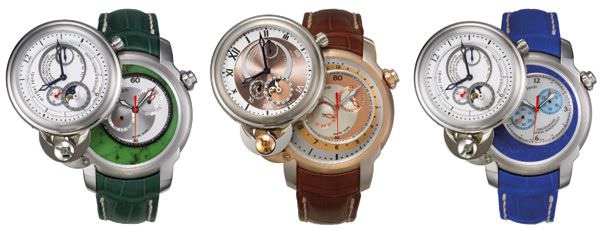
Michel Jordi Twins Heritage Line
Problems began to pile up: his ideas were unscrupulously copied; the diversification devoured his energy; his Switzerland-produced watches remained expensive, unable to compete with the wave of fashion pieces sweeping over the market. At the end of July 2002, he was forced to lay off workers, and finally in 2003, he was obliged to hold liquidation sales, bringing in 3 million CHF to pay back his suppliers. Jordi then closed the page on this chapter of his career. His is a journey that is symbolic of the inherent difficulties in the Swiss mid-range watch market, at a time when the large groups were gaining such power.
Birth of the Twins
But, you don’t know this man very well if you think these setbacks would stop him in his tracks. Towards the end of 2004, he announced the launch, under his name, of a whole new collection, situated in the very haut de gamme sector, called Twins. Jordi has thus made a stratospheric leap, passing from watches selling for 395 CHF to those with entry-level prices at 70,000 CHF. And again, even here, he is emblematic of the evolution in Swiss timekeeping, which has contenders all aspiring to reach the top. But let’s return to his Twins.
“One of the conditions for my return,” explains Michel Jordi “was to arrive with something different, something with a pronounced identity, an inno-vative product that would be a demonstration of watchmaking savoir-faire.” All of these qualities come together in the Twins collection, the first watches with a double case, one on top of the other, and sliding over the other, opening like a fan. The first series of Twins, the Heritage line, is composed of two movements. The first is manual winding, and displays the hours, minutes, small seconds, power reserve, date, and moon phases. The second is also manual winding, and is in the form of a small, single-pushbutton chronograph with an indication of 1/5th of a second, a large second timer in the centre, a 30-minute timer, and small seconds, as well as the possibility of displaying a second time zone. The finishing on the piece is absolutely perfect, both for the movements and for the double case with its very ingenious system of hinges. On the wrist, the timepiece has quite surprisingly very reasonable proportions.
To market his first double series of 9 pieces (only in white gold), Michel Jordi has chosen a rather unusual strategic location: luxury winter resorts. He has also paid particular attention to the packaging. The watch appears to be enveloped in a block of ice, enclosed in a large wooden case decorated with the insignia of the resorts, of the region, and of Switzerland. A secret compartment in the wooden case houses a beautiful magnifying glass, the watch’s guarantee, a catalogue, a spare leather strap along with a bracelet replacement tool.
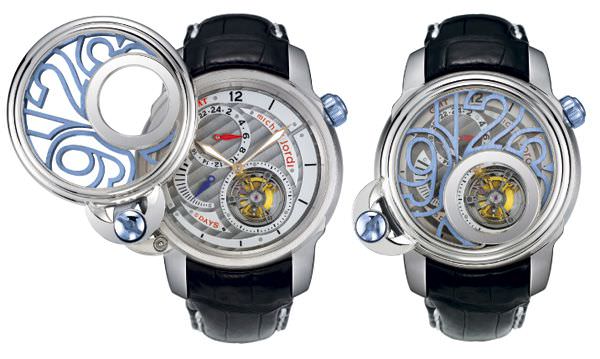
Twins Tourbillon Labyrinthe
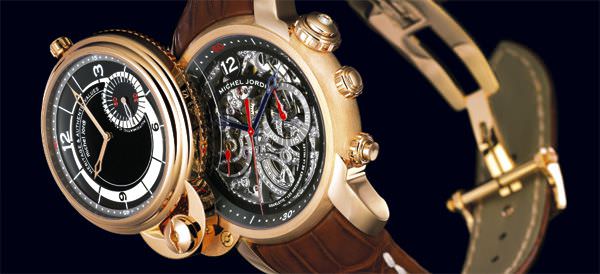
Twin Squelette
Developments
The success of this first round allowed Jordi to quickly extend his Twins offer. A jewellery version, called ‘Hidden Treasure’, is composed of 434 diamonds for a total of 6.03 carats, produced in a limited edition of nine pieces. Then, along came the Twins Lapis Lazuli, Twins Jade, and Twins Nacre. At the beginning of 2006, he produced the superb Twins Squelette – the upper case houses a Frédéric Piguet 71 movement, the flattest automatic movement in the world with the addition of a decentralized small seconds hand; the lower case reveals a marvellous skeleton version of a Valjoux 23 chronograph.
Yet, it is with his most recent piece, the Tourbillon Labyrinthe, that Michel Jordi really stands out, fully displaying the potential of double timekeepers. The topmost case displays a series of numbers in relief interlaced to form a labyrinth that opens out to a loupe (2.5x) that offers an astounding look into the tourbillion, located in the bottom case. This surprising flying tourbillon measures 13 mm in diameter, and really seems to be ‘flying’ since it is supported by two ruby bearings situated under the carriage. The lower case displays the hours, minutes, and seconds of a second time zone (GMT) as well as the five-day power reserve indicator. Today, with his 40 points of sale around the world (as compared to thousands earlier), Michel Jordi is a happy man, as are the fans of his exceptional pieces.
INSTRUMENTS & MESURES DU TEMPS
The lessons of an outsider
Pablo Dana is a good example of one of these fans, who spend so much energy satisfying their passion for timekeepers that, in the end, they create their own brand. This is the case of what is now happening with Instruments & Mesures du Temps. In the beginning, Pablo Dana, a financier who loves racing classic cars, noticed that it is quite difficult to read a chronograph while racing one of these vehicles because of the bumpy ride. One day, he met an artisan watchmaker named Christophe Golay of Golay Spierer, specialists in custom-made haute horlogerie timepieces. Along with Golay, Pablo Dana created his first watch, equipped with a large white seconds hand. “The result was perhaps not the world’s most beautiful,” concedes Dana, “but, at least, it was readable.”
Yet, contrary to what they expected, people did like the watch. Dana’s friends became interested in buying one, so Dana asked Golay if it would be possible to create a small series. Together, they designed a chronometer, formed an alliance, and made 22 pieces in gold and 22 in steel. All the watches quickly sold out.
This led the two men to form a real company, and to increase production: 222 pieces in gold and 222 pieces in steel. To succeed in their new venture, they brought together a network of artisans, all Swiss, under the label of Instruments & Mesures du Temps. A new brand was thus born. “Our idea is absolutely not to create a traditional brand,” explains Dana, “because all of our watches are personalized or personalizable. This has nothing to do with being snobbish, but rather it lets each owner say ‘this is MY watch’.”
The new brand’s first collection is called ‘Scuderia22ventidue’ (as you might guess, the number 22 is Dana’s favourite). It is a watch with a strong personality, which features a fluted case measuring 45 mm, enclosed by two 1.2 mm sapphire crystals, held together by twelve screws, and water-resistant to 100 metres. Inside, the automatic chronograph movement offers a date and power reserve (42 hours) indicator. Each dial – and there is an impressive palette of possibilities – can be personalized by the inscription of the owner’s name on the power reserve indicator. “We want to design each watch in collaboration with the client by involving him or her in the creation process, which requires three months per watch,” explains Robert Saiah, in charge of distribution. “This involvement continues to the after-sales service that we are particularly concerned with and that we want to be absolutely optimal, just like the quality of our 100 percent Swiss Made products. We are thus developing the infrastructure that will allow us to send a watchmaker to the owner’s home every two years to check and service the watch, replace the bracelet, etc. In addition to our direct sales, we want to open 22 sales points in the world, as well as 22 in Switzerland. But, they will be, for the most part, out of the ordinary,” Saiah quickly adds. “We are not going to remain only with jewellery and watch retailers, but we want to partner with stores that are original, different, and exclusive.”
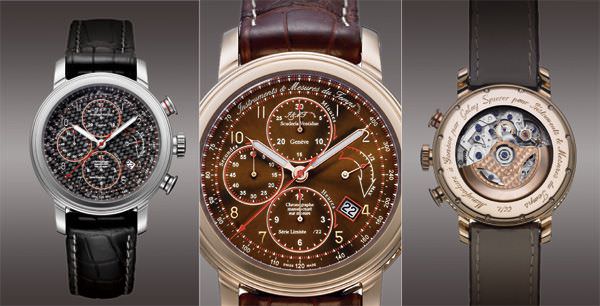
Scuderia22ventidue
Projects that are a little crazy
The fact that Pablo Dana was, in the beginning, considered to be a watchmaking industry ‘outsider’ coupled with his exceptional energy, has led him to come up with ideas that are totally new and unheard of. In the filing cabinets of Instruments & Mesures du Temps, the projects are piling up. Already in development is a column-wheel flyback chronograph, equipped with a system of three interdependent hands that will allow the wearer to simultaneously and instantaneously measure three different times on three distinct scales, a feature that is quite useful during a race. There are also other projects, under consideration, that deserve to be mentioned since they are in the realm of haute horlogerie. One project that is a little crazy, but yet quite incredible, if we think about it for a moment, is a diver’s watch that floats if dropped into the water. There is also a luxury chef’s model equipped with a timer to help measure cooking times. And, then, there is a robust hunter’s version, still in the haute horlogerie sector, that is visible at night, and seemingly immune to shocks, humidity, dust, and scratches.
This is continued proof that the renewal of watchmaking often passes by the passion of certain independent and free spirits. As a last detail regarding Instruments & Mesures du Temps, for each watch sold (prices range from 17,000 CHF to 29,000 CHF depending on the material), the brand donates from 500 CHF to 1,000 CHF to the Jan & Oscar Foundation, whose work is dedicated to helping educate children who are victims of the tsunami in Thailand.
Source: Europa Star December-January 2007 Magazine Issue





